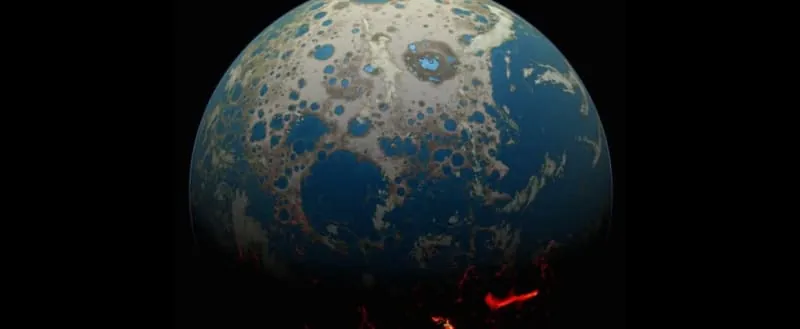
Groundbreaking Discovery Uncovers the Billion-Year-Old Secrets of Earth's Water Source!
2025-04-07
Author: Wai
Introduction
Water is the lifeblood of our planet, but its true origin has been a topic of scientific debate for decades. Researchers have speculated whether Earth’s water came from icy comets, rocky asteroids, or a combination of both. Each theory presents a fascinating narrative about how our planet transformed into the blue world we know today.
Recent Findings on Comet 67P
Recent findings related to the comet 67P/Churyumov-Gerasimenko have brought this debate back into the spotlight. Enhanced data from this comet suggests that comets might indeed have played a crucial role in delivering water to Earth. Central to this contention are hydrogen isotopes, specifically the crucial ratio of deuterium to hydrogen (D/H), which serves as a cosmic fingerprint indicating where an object originated in our solar system.
The Role of Deuterium
Deuterium, a heavier isotope of hydrogen, bonds more readily with oxygen in cold conditions. Consequently, icy bodies that formed in the frigid outer regions of the solar system display higher D/H ratios—allowing scientists to trace the historic pathways of water. Comparisons of these ratios in various celestial bodies have revealed surprising results.
Analyzing Jupiter-family Comets
Initially, data from Jupiter-family comets suggested their ice composition closely matches that of Earth's oceans, supporting the theory that these comets could be the water's original carriers. However, the Rosetta mission, which explored comet 67P, unexpectedly found a D/H ratio three times greater than that of Earth’s oceans. This revelation sparked intense debate and led scientists to reevaluate previous conclusions.
Kathleen Mandt's Research
NASA planetary scientist Kathleen Mandt took it upon herself to unravel this mystery. By applying advanced statistical techniques, her research team reexamined over 16,000 quality measurements gathered during the Rosetta mission. They discovered that the comet's D/H ratio varied within its coma—a cloud of gas and dust surrounding the comet—showing correlations with dust density. This crucial insight indicated that previous D/H measurements may not accurately reflect the comet’s true composition.
The Impact of Dust on Isotopic Readings
As dust particles move through the coma, they carry deuterium-rich water, which can skew the readings. More importantly, as these particles travel away from the comet, their enriched water dissipates, presenting a more precise snapshot of the comet’s intrinsic water composition.
Unraveling Early Solar System Mysteries
These findings shed light on how dust can skew isotopic readings. As a comet approaches the Sun, heat causes it to release gas and dust, enabling water molecules containing deuterium to cling to dust grains. The subsequent travel of these grains into the coma creates localized isotopic anomalies, complicating our understanding of the comet's true water signature.
The Amalgamation of Water Sources
This research has significant implications for unraveling the early solar system's mysteries. Before the formation of the Sun, frigid temperatures allowed volatile substances to freeze onto dust, forming ice rich in deuterium. As conditions warmed, water vaporized and mixed with hydrogen, but these variations across the solar system allowed for differing isotopic ratios between inner and outer solar system bodies.
Bombardment Theories
Many scientists propose that Earth’s water emerged from an amalgamation of sources, including volcanic activity that released water vapor. More significantly, some researchers highlight the intense bombardment of asteroids and comets around 4 billion years ago as a crucial contributor to the planet's watery profile. While asteroids have long been recognized as key players, Mandt's study reignites the conversation about the role of Jupiter-family comets like 67P.
Variability in Cometary Isotopic Ratios
Interestingly, other comets from the Oort Cloud and Jupiter-family group have demonstrated diverse D/H ratios, some closely aligning with Earth’s water while others diverge. For instance, comet C/2014 Q2 Lovejoy exhibited both terrestrial and enriched D/H ratios across different measurements, indicating notable variability within a single comet. Such discrepancies complicate our efforts to synthesize accurate isotopic analyses and may even inform future studies on the habitability of exoplanets.
The Importance of Ongoing Research
The ongoing research into isotope variability in comets is vital for understanding the solar system's formation. As new missions are launched to scrutinize these ancient celestial bodies, Mandt stresses the importance of incorporating dust effects into future studies to improve accuracy.
Conclusion
Ultimately, the quest to trace Earth’s water back to its origins reveals the complexities of cosmic processes. Comets like 67P, with their unique isotopic signatures and intricate dust-water interactions, hold essential clues that enrich our understanding not only of Earth but also of other potentially habitable worlds in the universe. Each new discovery continues to rewrite the story of Earth's precious water, inviting us to explore the ancient past of our planet in ever more nuanced ways.


 Brasil (PT)
Brasil (PT)
 Canada (EN)
Canada (EN)
 Chile (ES)
Chile (ES)
 Česko (CS)
Česko (CS)
 대한민국 (KO)
대한민국 (KO)
 España (ES)
España (ES)
 France (FR)
France (FR)
 Hong Kong (EN)
Hong Kong (EN)
 Italia (IT)
Italia (IT)
 日本 (JA)
日本 (JA)
 Magyarország (HU)
Magyarország (HU)
 Norge (NO)
Norge (NO)
 Polska (PL)
Polska (PL)
 Schweiz (DE)
Schweiz (DE)
 Singapore (EN)
Singapore (EN)
 Sverige (SV)
Sverige (SV)
 Suomi (FI)
Suomi (FI)
 Türkiye (TR)
Türkiye (TR)
 الإمارات العربية المتحدة (AR)
الإمارات العربية المتحدة (AR)